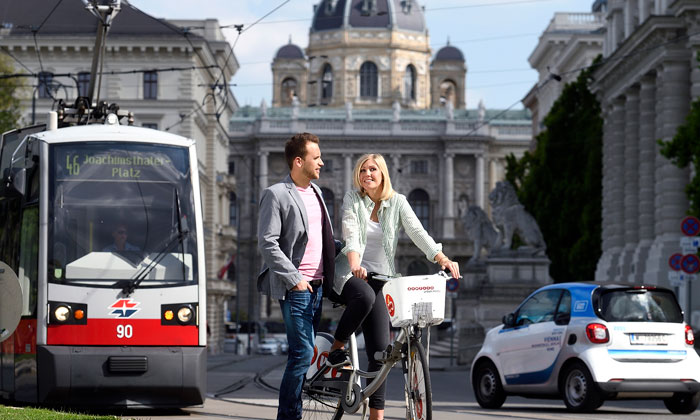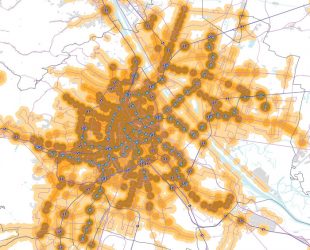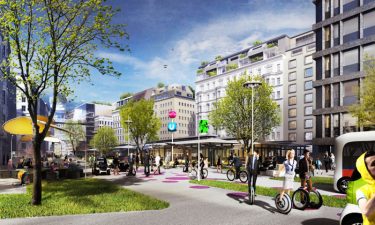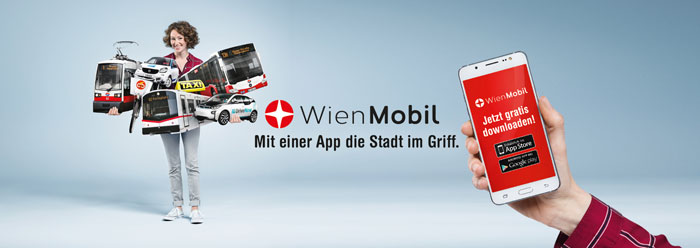Making Vienna smarter and more digitally connected
- Like
- Digg
- Del
- Tumblr
- VKontakte
- Buffer
- Love This
- Odnoklassniki
- Meneame
- Blogger
- Amazon
- Yahoo Mail
- Gmail
- AOL
- Newsvine
- HackerNews
- Evernote
- MySpace
- Mail.ru
- Viadeo
- Line
- Comments
- Yummly
- SMS
- Viber
- Telegram
- Subscribe
- Skype
- Facebook Messenger
- Kakao
- LiveJournal
- Yammer
- Edgar
- Fintel
- Mix
- Instapaper
- Copy Link
Posted: 6 March 2018 | Alexander Scholz - Vienna City Administration, Gregory Telepak - Vienna City Administration | No comments yet
While Vienna has developed its public transportation systems and accompanying infrastructure tremendously in recent years, the term ‘smart city’ has encouraged further debate on urban mobility. Gregory Telepak, Technical Officer and Project Manager, and Alexander Scholz, Junior Expert in Mobility, both from the Vienna City Administration, detail Vienna’s plans to continue improving its technologies and transport offerings.


When visitors talk about their experiences in Vienna, they often highlight the network of subways, trams and buses which enable quick journeys from one activity to the next. Easy access has been a guiding principle in creating and managing Vienna’s transport system and is now reflected everywhere, from the system of lines to ticketing options. One example is the 365 Euro annual pass, which has received popular reviews with the Viennese. Because services run in close intervals – almost all the time and to nearly all places – detailed timetables are not always required and so traditional methods of communicating the services are often still sufficient, such as the map system.
These high standards are the results of years of hard work following a consistent strategy and significant investment. Planned future tram projects and subway extensions, such as the new U2/U5 development, also show that there are still further advancements to be made. The internet, and its availability through mobile devices, has created huge opportunities to be able to contact customers and assist them with mobility choices. For a long time, timetables and real-time traffic information databases were not open to multinational IT giants, so solutions – like ‘qando’, a routing and real-time information app – were developed by Vienna’s main, publicly owned transport operator, Wiener Linien.
Keeping up with developments is a huge challenge, one which some claim to be impossible without billions of dollars, but other cities’ adaptations of solutions developed in Vienna show that there is, at least for the moment, a chance. The city’s decision makers recognise that this chance needs to be seized in order to deliver public policies, not only in regards to infrastructure, but also factors such as impartial information that is readily available and openly accessible.
Connecting technology to quality of life


The coverage of public transport services in Vienna encompasses nearly all settlement areas, with a large share (illustrated in brown) enjoying the highest quality accessibility
The introduction of the term smart city initiated a large scale debate in Vienna and led to the creation of the ‘Smart City Wien Framework Strategy’, adopted by the city council in 2014. At the time, the unique strategy was not limited to technological progress but had a broad claim to maintaining and improving the quality of life, focusing attention upon the citizen’s perspective – as well as the many people working in and visiting Vienna.
Improving the efficiency and quality of life was, and still is, the goal, with innovation and technology as the tools. To do so required exploration of the existing structures, targeting first what did not appear innovative, modern or digital.
As described earlier, the public transport system in Vienna already incorporates many smart improvements. As more concrete forms of Mobility-as-a-Service, sharing schemes and automation continue to progress, the challenges and opportunities are both increasing rapidly.
Integrating smart transport solutions digitally and physically
In the past few years, the range of mobility services has become larger and more diverse, to the point that it is becoming a challenge to keep track of them all. Apart from an extensive public transport network, several private car-sharing operators, bike-sharing providers and a variety of individual initiatives in different areas of mobility have come into existence.
To further the idea of providing information about the mobility services from one source, the City of Vienna’s subsidiary, Upstream, worked on developing both a back-end and a user interface which could offer information on a broad range of mobility services, including ticketing and payments. After a thorough beta testing phase, ‘Wien Mobil’ became available in mid-2017 and built on a network of nearly 10 mobility service providers in Vienna. The strong position of public transport in the market and previous experience with mobility information facilitated this development.
Smarter Accessibility
Complementing investment in infrastructure to provide a barrier free public transport system, smart technology is seen as key in improving the mobility of citizens with special requirements. Focus groups are elderly people, those with visual impairments and other disabilities, and also families and people using strollers.
Most of the work regarding infrastructure is already done: all Wiener Linien stops, and most railway stations, are equipped with elevators to the platforms and multi-sensory guidance systems – even improved ticket vending machines for wheelchair users are available. Information about the services at stations (including current out-of-order notices for elevators) is integrated in the general route planners and real-time traffic information apps. In addition, there are custom designed routing planners for people with hearing and visual impairments, for example POPTIS – the Pre-On-Post-Trip-Information-System.
Access to mobility information for everyone was a major aspect of the ‘stop of the future’ project, which led to a new design of public transport stops including a multisensory-information-point (MUSIP), which gives users location-based visual, acoustic, tactile and sign language information about current public transport traffic.
While all buses and underground trains in Vienna are already low entry or boast level access from platforms, the number of modern trams with no steps between pavement/station and vehicle is constantly growing – currently about 50 per cent of the fleet. The remaining high-floor trams will be replaced in 2018 and similarly, the fleet of the S-Bahn will be improved by an additional 90 low-floor EMUs leading up to 2020 – the last missing piece in a barrier-free public transportation in Vienna. In the meantime, information about whether or not the vehicle for your route will be barrier-free is available at real-time displays at stops, in apps and route planners – and in some cases even timetables in the longer term.
Of course barrier-free mobility doesn’t end with public transportation, meaning that guidelines for barrier-free planning in Vienna also include housing, public spaces and public buildings.
This gives a great boost to the international trend ‘sharing instead of owning’ which also manifests itself in Vienna. Smart technologies and connectivity have made sharing easier and more accessible. Vienna identified the great potential in these developments and the contributions they could make to multimodality early on. The City of Vienna was a pioneer in the development of good car- and bike-sharing systems, despite encountering setbacks. In the future, services available shall be expanded, with private initiatives and commercial mobility providers playing an important role. Beside the virtual dimension of access, there is also a need to improve the physical dimension.


A vision for a future urban scene including multimodality and shared autonomous mobility services
A few cities have already experimented with concentrating mobility services in one area, thus creating hubs for the mobility of the future. In Vienna a pilot project is under way within the framework of the Horizon 2020 funded project ‘Smarter Together’. The mobility strategy for the project area includes electric car-sharing, bike-sharing, an app for easier access to mobility services and electronic vans for the postal service, as well as new logistic solutions, mobility advice and information screens on site. Combined, this translates into an annual saving of 45 tonnes of CO2.
However, mobility solutions are only one pillar in a larger concept that is developed with citizens’ participation and includes affordable housing, technical solutions for energy efficiency, and renewable energies. This is a great example of how smart technologies are embedded in Vienna.
To strategically structure activities beyond individual pilots, the City of Vienna has identified two different types of mobility service points: one that is open to all citizens and shall be operated by the public transport operator; and one where a defined group of users may have preferred access.
The latter would be managed and operated by private organisations and may be a solution close to people’s homes. Currently this seems realistic in the context of larger residential projects. To guarantee mobility for all Viennese citizens, including those who do not want to own a car, it is crucial to strongly support both types of mobility points.
Regarding the former type, it is planned to implement a network of enhanced mobility hubs “Mobilitätsstationen”. These hubs are meant to give uncomplicated and fast access to primarily low-emission, comprehensive mobility around the clock. It can also be a central facility in a new urban development area or to strengthen structures in existing neighbourhoods. A variety of vehicles and services can be booked and used, and in this way, mobility relevant services can be bundled, well-structured and in one place.


Multimodal transport access has been made available through the new Wien Mobil App
Is automation the next evolution of sharing?
Automation and the use of autonomous vehicles in transport are subjects that city administrators are now beginning to face. Decision makers and experts in Vienna identified the dynamics several years ago and joined the growing debate. Certainly, automation offers huge benefits, including road safety, potential efficiency gain and reusing urban space, but scenarios threatening urban quality of life are just as easily imaginable.
To unlock the potential of autonomous vehicles in cities, shared rides will be the most important key. In successful cases, the borders between public and private transport will also blur – hopefully adding the benefits of either one to the other: more direct on-demand services in public transportation and more efficiency in using private vehicles, for example.
There is significant debate about when autonomous vehicle technology will be ready, but whether it’s sooner or later, the question of how mobility services are delivered, how business models work and which regulatory framework is needed are issues that are even more pressing from a city perspective.
Looking at developments today, Vienna seems to be in a great position for the future, with high capacity, high efficiency public transport infrastructures in place, and dynamic development of the transport service sector with a neutral platform that puts citizens’ needs front and centre.
Biographies




Issue
Issue 1 2018
Related organisations
Vienna City Administration
Related people
Alexander Scholz, Gregory Telepak








